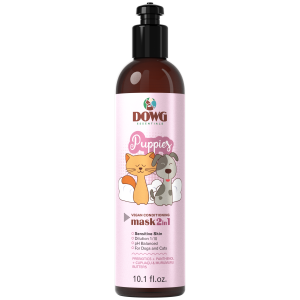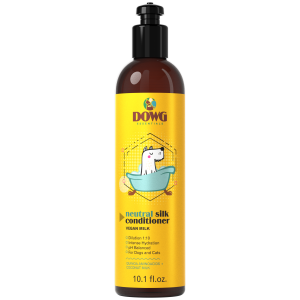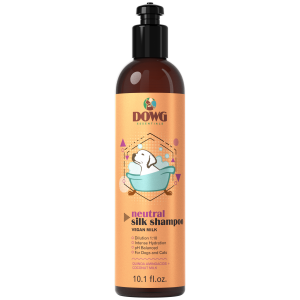Skin Problems In Dogs
As a dog owner, it’s important to be aware of the various skin problems that can affect your furry friend. These issues can cause discomfort and pain, just like they do in humans. In this article, we’ll explore some of the most common skin problems in dogs. We’ll take a look at what causes them, the symptoms to watch out for, and the treatment options available. Whether you’re an experienced dog owner or a newbie, knowing about these issues can help you ensure your dog’s well-being and happiness.

What are Dog Skin Problems?
Dogs, being naturally active and playful creatures, often experience minor skin irritations like occasional itches or grazes. However, when these fleeting discomforts escalate into persistent scratching and noticeable issues like bald patches, the presence of parasites, or dry and flaky skin, it’s indicative of an underlying dog skin condition. Such conditions can range from allergies to parasitic infestations or skin infections. Flea Allergy Dermatitis (FAD) is a common concern, where even a single flea bite can trigger intense allergic reactions, causing itching and skin inflammation. Additionally, dogs might suffer from atopic dermatitis due to allergies to environmental factors like pollen, resulting in chronic skin problems in dogs. Recognizing these signs early on and seeking veterinary care is vital to ensure the well-being and comfort of our canine companions.
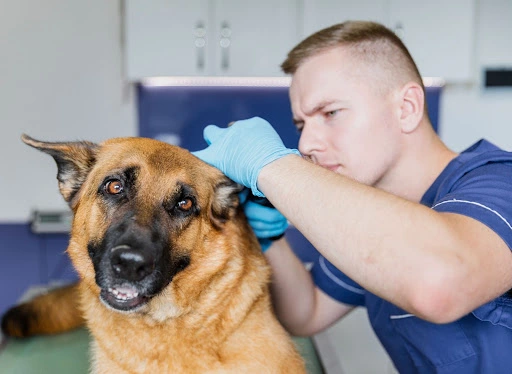
Common Skin Problems in Dogs
Let’s delve into 13 prevalent dog skin problems, exploring their symptoms and underlying causes.
Allergic Skin Disease
Just like humans, dogs can have allergic reactions to things like food, grass, mold spores, dust mites, and more. These allergies can cause an allergic skin disease called atopic dermatitis. Signs include excessive licking, chewing, and scratching, as well as red, inflamed skin, hair loss, and secondary skin infections. Typical areas affected include the paws, belly, armpits, face, and ears.
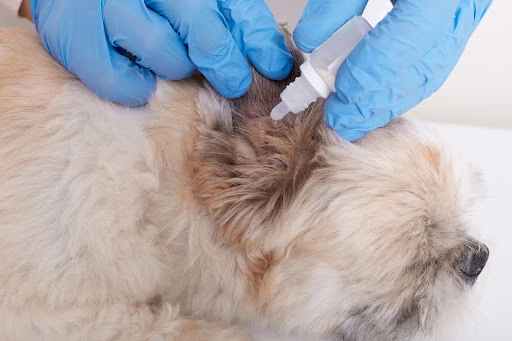
Allergic skin disease is one of the most common skin conditions veterinarians see in dogs. It’s estimated to affect 10-15% of all dogs. Any dog can develop allergies, but certain breeds seem more prone. Allergic skin disease in dogs is typically managed through avoidance of allergens, medications, and special baths. Medications like antihistamines and steroids help to control itching and inflammation. Antibiotics treat secondary infections. Medicated shampoos and wipes provide relief between baths. Other supportive care like nutritional supplements may also be beneficial.
Flea Allergy Dermatitis
Some dogs have severe allergic reactions to flea bites, even if only one or two fleas are present. This is called flea allergy dermatitis (FAD) or flea bite hypersensitivity. Dogs with FAD experience incredibly itchy skin, typically around the tail base, hind legs, abdomen, and neck. Red bumps, rashes, hair loss, scabs, and hot spots can develop. The itch-scratch cycle tends to perpetuate the condition.
Flea allergy dermatitis is more common in warmer climates where fleas thrive year-round. For dogs with FAD, strict flea control is essential to prevent reactions. Oral and topical flea preventatives, frequent grooming, and vacuuming help keep environments flea-free. Anti-itch shampoos, medications, and immune-modulating therapies help manage symptoms. Avoiding other skin irritants is also important.
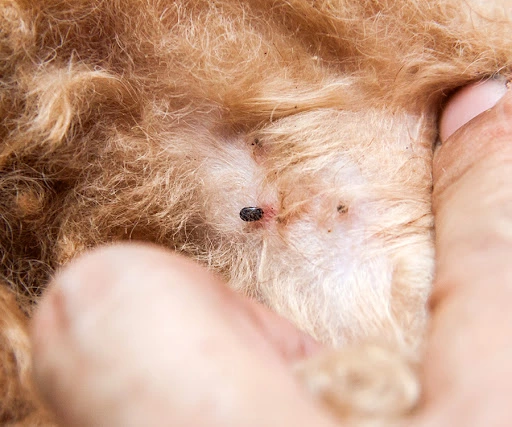
Yeast Infections
Yeast naturally lives on a dog’s skin but overgrowth of yeast can lead to skin infections. Dogs with yeast infections often have very itchy, greasy skin with a characteristic odor. The ears, paws, armpits, neck, and anal area are typical locations for yeast overgrowth. Dark skin and skin folds provide ideal environments for yeast to flourish.
Obesity and allergies are risk factors for developing yeast skin infections. When a dog’s immune system isn’t keeping the yeast in check, the yeast populations explode. Antifungal shampoos will help kill the yeast overgrowth on the skin. Oral antifungals may also be prescribed. Identifying and addressing any underlying problems, like allergies or hormonal disorders, is also important for long-term management.
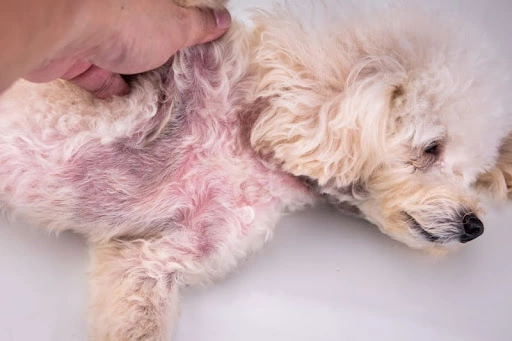
Bacterial Infections
Bacterial skin infections in dogs usually appear as itchy, red, oozing, scabbed, or crusty areas. They often affect areas with folds, such as facial wrinkles, lips, armpits, or vulva. The infections may start superficial but can progress to involve deeper skin layers. Dogs with allergies or other conditions causing skin irritation are more prone to developing bacterial infections.
Staph and strep are two common bacterial causes of skin infections in dogs. Other bacteria like Proteus and Pseudomonas can also be involved. Treatment typically includes antibacterial shampoo and oral antibiotics. Keeping skin folds clean daily helps prevent recurrence. Longer-term antibiotic therapy is sometimes needed for chronic cases.

Ringworm
Contrary to its name, ringworm is a fungal infection. It’s caused by several species of Microsporum or Trichophyton fungi. It causes round, scaling, hairless patches that continue to spread outward. Young dogs and dogs with weakened immune systems are most at risk. Ringworm is highly contagious and can spread rapidly between dogs through direct contact or shared bedding and grooming supplies. Humans can also contract ringworms from dogs.
Ringworm has a characteristic appearance but skin scrapings may be examined under a microscope to identify fungal spores. Oral antifungal medication is typically prescribed for 1-2 months. Antifungal shampoos and dips may also be used.

Mange
Mange refers to skin diseases caused by mites. Different types of mange mites can affect dogs. Sarcoptic mange is caused by Sarcoptes scabiei mites which burrow into the skin and cause severe itching and irritation. Hair loss, crusting, and thickening of the skin develop. Scabies in people is caused by a closely related mite species.
Demodectic mange typically results in hair loss starting around the eyes and mouth and eventually spreading over the body. Puppies, pregnant or nursing dogs, and dogs with weakened immune systems are most susceptible.
Notoedric mange (feline scabies) comes from the Notoedres cati mite. Affected dogs develop intense itching and a severely crusted rash, usually around the face, ears, armpits, and groin.
Mites are microscopic so diagnosis is made by examining skin scrapings under a microscope. Sarcoptic mange is very contagious between dogs so isolation is recommended. Treatment involves antiparasitic dips, oral ivermectin, and topical medications. More than one treatment is often needed.

Hot Spots
Also called acute moist dermatitis, hot spots refer to areas of skin irritation and infection that crop up suddenly. They can appear anywhere but commonly affect the head, hips, or chest. Hot spots initially appear as red, warm, moist lesions that rapidly become hairless, oozing, and very painful. The dog tends to lick, chew, and scratch the area, exacerbating the condition.
Hot spots result from uncontrolled licking, chewing, and scratching. This self-trauma to the skin allows a bacterial infection to set in. Any skin irritation can trigger this behavior, often due to an underlying problem like fleas, allergies, poor grooming, or ear infections. Heat and moisture further promote the infection. Early treatment is vital to minimize discomfort and prevent hot spots from spreading.

Seborrhea
Seborrhea refers to flaking and greasiness of the skin often accompanied by a foul odor. The thick, waxy sebum clogs hair follicles resulting in flaky, scaly skin with areas of hair loss. Seborrhea has many underlying causes, including allergies, thyroid disorders, hormonal imbalances, and bacterial or fungal infections. Stress and poor nutrition may also play a role.
Treatment depends on the cause and severity. Antifungal shampoos help to reduce yeast overgrowth and associated odors. Anti-dandruff shampoos help to control scaling. Topical creams treat infection and inflammation. Identifying and addressing any underlying medical conditions is key for long-term control.
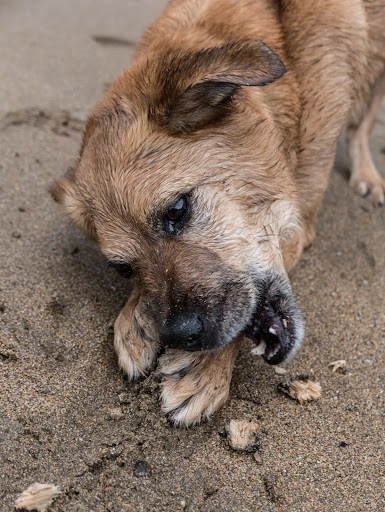
Intertrigo
Intertrigo refers to inflammation of skin folds due to moisture, friction, and lack of air circulation. It typically occurs in facial wrinkles, vulva, tail folds, and between toes. Obese dogs with heavy folds are especially prone to intertrigo. The affected areas become reddened, and swollen, and can develop hair loss and a discharge. Secondary yeast and bacterial infections commonly occur, causing severe irritation.
Keeping skin folds clean and dry is important for both treating and preventing intertrigo. Topical antifungal and antibacterial creams or ointments treat infections. Hydrocortisone helps reduce inflammation. Surgery may be considered to correct some excessive skin folds contributing to the condition. Maintaining a healthy weight also lowers intertrigo risk.

Pyoderma
Pyoderma is the medical term for bacterial skin infections. It may involve only the superficial epidermal layer or could extend into the deeper dermal layer. Surface pyodermas lead to crusting, itching, hair loss, and the development of pustules or collarettes around hair follicles. In deep pyodermas, painful nodules, abscesses, and draining fistulas develop.
Short-coated breeds and dogs with excessive skin folds are at increased risk of pyoderma infections. Staph and Proteus are common causative bacteria. Oral antibiotics, antibacterial shampoos, and hot compresses treat pyoderma. However, an underlying problem like allergies, endocrine disease, or immune disorders often needs to be resolved for long-term clearance. Prompt vet care provides the best chance for quick recovery and prevents the infection from worsening.

Lick Granulomas
Also known as acral lick dermatitis, lick granulomas appear as large, raised, hairless lesions. They develop from chronic, repetitive licking of a particular area, usually on the front legs or paws. The cause is often unknown but anxiety, stress, boredom, allergies or other skin irritation can trigger the obsessive licking behavior. The wet environment and mechanical irritation from licking induce tissue inflammation and thickening of the skin.
Lick granulomas can be difficult to manage and are prone to recurrence. Preventing access to the area with an e-collar, bandage, or body suit can help break the licking cycle and allow healing. Behavioral therapy or anti-anxiety medications address any underlying psychological factors. Topical corticosteroids, antibiotics, and other medications treat secondary infections and inflammation.

Skin Tumors
Skin tumors are abnormal growths arising from skin cells. They may be benign (non-cancerous) or malignant (cancerous). Common benign tumors include histiocytomas, sebaceous adenomas, and lipomas. Cancerous tumors such as mast cell tumors, melanoma, and squamous cell carcinoma must be treated more aggressively to prevent metastases.
Any new lump or bump on your dog’s skin should be evaluated by a veterinarian. Your vet will recommend a biopsy, staging tests, and removal or treatment as appropriate for the specific tumor type. Early detection and treatment are key to optimizing outcomes, especially with malignant neoplasms. Regular skin examinations facilitate early identification of any suspicious growths.

Alopecia
Alopecia is the medical term for areas of hair loss or baldness. In dogs, there are many causes including external pressure, parasitic infections, hormonal abnormalities, metabolic disease, and immune disorders. Alopecia often begins with small circular patches but can spread to more generalized hair loss. Diagnostic tests like skin scrapings, cultures, biopsies, and bloodwork help determine the underlying cause.
Some types of alopecia in dogs are not medically serious and even reversible, such as seasonal flank alopecia. However, in cases of endocrine disorders, autoimmune disease, or a parasitic infection causing hair loss, treatment of the underlying condition is needed to promote regrowth. Appropriate use of medications, supplements, and therapies supports skin health and optimal coat regrowth.

Tips to Avoid Skin Problems in Dogs
Regular Grooming
Regular grooming is not just about keeping your dog looking its best. It’s also an opportunity to check for signs of “dog skin conditions,” such as lumps, bumps, or unusual “dog skin rash.” Using a gentle, hypoallergenic shampoo can also prevent potential “dog skin allergies.”
Healthy Diet
A balanced, nutritious diet is pivotal in maintaining healthy skin and coat, preventing potential “dog skin disease.” Ensure your dog’s diet is rich in omega-3 fatty acids, which can be found in fish oil and flaxseed oil.
Flea and Tick Control
Implementing a regular flea and tick control regime is crucial to avoid conditions like flea allergy dermatitis. Consult your vet for the best preventative treatments.
Regular Vet Check-ups
Routine vet visits can help identify and address “dog skin conditions” before they become a significant issue.
Avoiding Allergens
If your dog has known allergies, be it environmental or food-related, ensuring they avoid these triggers is crucial in preventing allergic dermatitis and subsequent “dog skin infection.”
Proper Bedding
Ensure your dog’s bed and living area are clean and made from materials that do not irritate their skin. This can prevent potential “dog rash on the belly” and other skin issues.

Conclusion
In conclusion, maintaining a keen awareness of common skin problems in dogs is essential for responsible pet ownership and ensuring the overall health and well-being of our beloved canine companions. Dogs, being active and playful, are prone to occasional skin irritations such as minor itching and grazes. However, when these minor issues escalate to persistent scratching, bald patches, parasites, or dry and flaky skin, they likely indicate an underlying skin condition. Flea Allergy Dermatitis (FAD), atopic dermatitis, hot spots, and yeast infections are among the prevalent skin concerns that can significantly impact a dog’s comfort and quality of life. Prompt recognition of symptoms and seeking professional veterinary care are crucial steps in managing and treating these skin problems effectively. Additionally, maintaining a proper grooming routine, providing a balanced diet, and creating a healthy living environment can contribute to preventing and managing these skin issues, ensuring our canine companions lead happy and itch-free lives.
-
Add To CartAdd to WishlistAdd to Wishlist
-
Add To CartAdd to WishlistAdd to Wishlist
-
Add To CartAdd to WishlistAdd to Wishlist
-
Add To CartAdd to WishlistAdd to Wishlist
-
Add To CartAdd to WishlistAdd to Wishlist
-
Add To CartAdd to WishlistAdd to Wishlist



